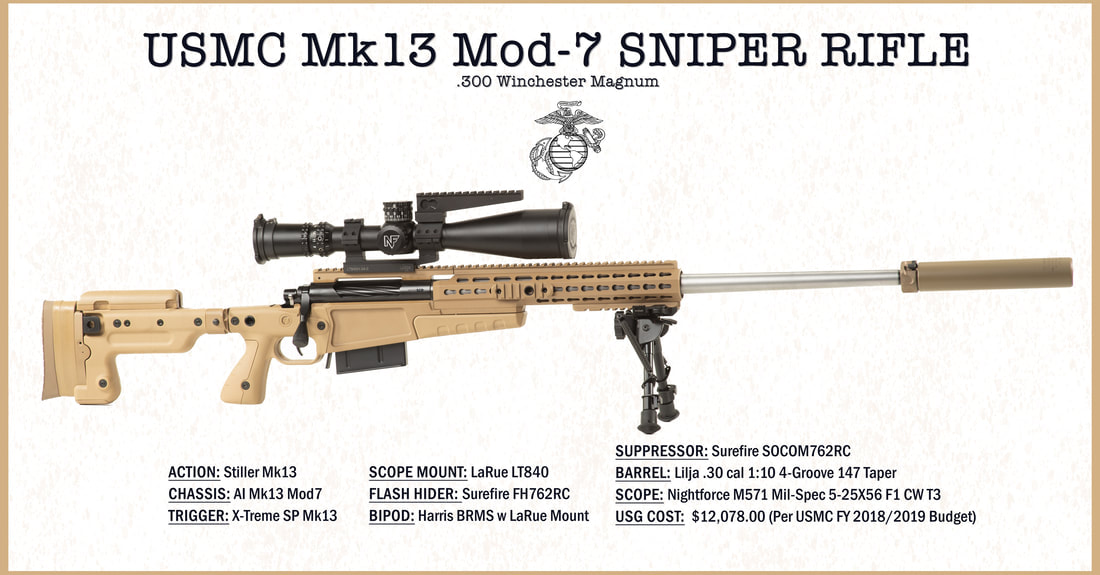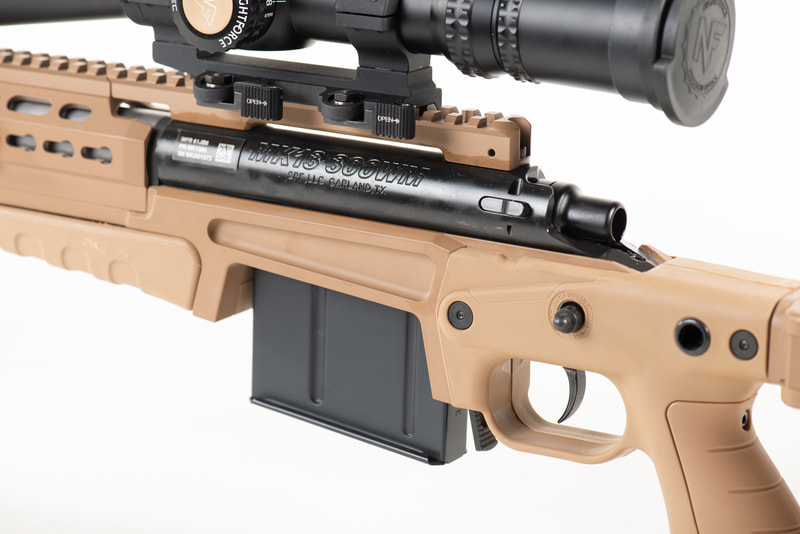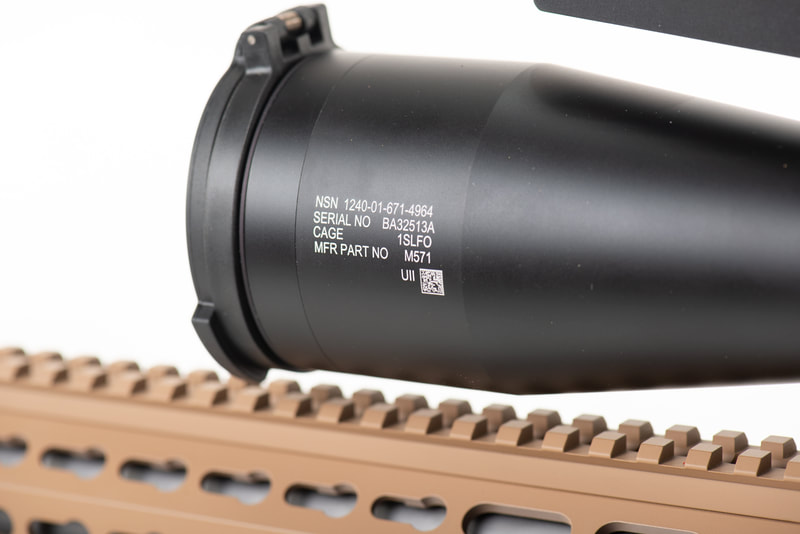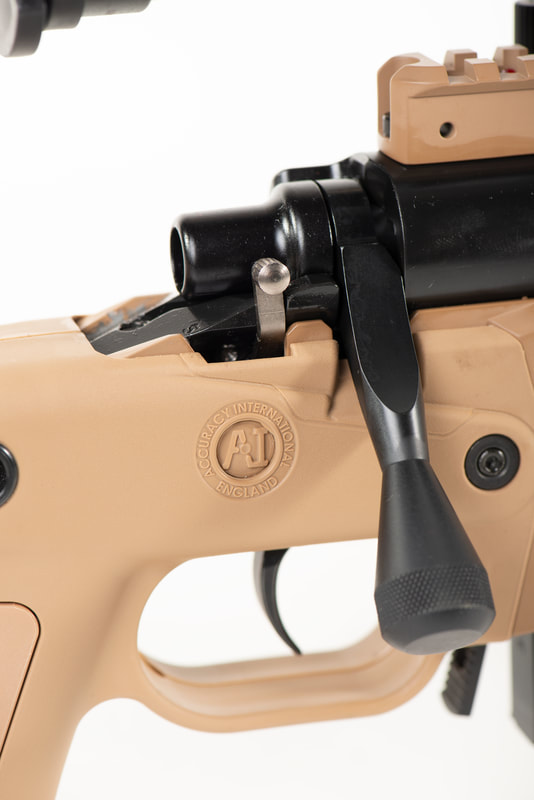|
Finally, after sixty plus years of Marine snipers making due with the 7.62X51 NATO cartridge, the Corps has given our long-range death dealers a tool to bring them into the 21st century. Little is known outside certain circles of the Navy's Mk13 series of rifles and how they came about. I thought I'd take the time to data dump what I know about the .300 Win Mags the Navy has been building for thirty plus years.
NAVY SHOOTING TEAM Back in 1991-92, the United States Navy shooting team was looking to gain an edge on the opposition. The 7.62X51 cartridge wasn't cutting the mustard on windy days at the 1000 yard line. The shooting team looked to the .300 Winchester Magnum to field a new series of long-range competition rifles. The .300WM allowed the team to push heavier bullets at faster speeds, thus making the effects the wind had on the projectiles less than that of it's lighter and slower 7.62X51 little brother. Early on the Navy team saw a noticeable improvement downrange. The gunsmiths who were tasked with building the team rifles were the same guys responsible for building the sniper rifles for the SEAL teams. The smiths and the SEAL snipers both wanted the teams to have the same capability. MOD ZERO IS BORN The original rifles "Mod 0" version of the Mk13 had primarily 26.5" barrels with a few sporting 27". The scope base and ring set up on the 1st issue were typically one one-piece base with mounting slots, more akin to a typical Weaver two-piece scope base. Having Mil-Stander 1913 Picatinny rails was not a thing back then. NSW didn't get a solid hold of configuration management until later in 90's thus why so many variances. At the time the only rifle mounted night vision device teams had access to was the KIGRE Simrad KN-200, then later on the KN-250. Both of these night vision scopes were mounted to the day optic via a special scope ring cap that enabled the device to mount over and onto the day scope. The KN's used a reflex mirror to get the night vision picture into the day scope. Back then the Joint Special Operations Programs office (JSOP) did not exist, so the Mk13 rifles were strictly issued to the SEAL teams. Over the years the SEAL snipers and NSW armorers made small improvements to the rifles such as modifying the bolts to install SAKO style extractors. By the time the guns were being issued with desert tan stocks, a newer technology "in-line" night vision systems were coming online. These did not require the old "piggyback" mounting system. The choice mount at the time was the McAnn Industries rail. Early versions had no provisions for adding side accessories, the 2nd generation of McAnn rail enable SEALs to mount IR lasers at the 3 and 9 o'clock position. CRANE & SOCOM Around 2002 Naval Surface Warfare formed the JSOP office to share program technology with other SOCOM units. This opened up the unique capabilities of the early Mk13's to other SOF units who had a similar demand. GOING QUIET Come 2003 SEAL teams were asking for suppressed versions of the Mk13. The US Army's Ranger Regiment had commissioned a few Mk13's to be built specifically for them to evaluate the .300WM capability further. This is where the Mk13 Mod 2 came about. The Mod 2 brought about an Accuracy International AICS stock 2.0 (folder) and the McAnn rail was dropped for the Remington MARS rail. In addition to these changes, the barrel was threaded at the muzzle and fitted with a thread protector. The Ranger said they were going to install their own flash hider/suppressor mounts. At the same time NSW Crane began exploring various suppressor options for the teams. The teams already had a suppressor in the system that had a 7.62mm hole in it, and could also handle the excess pressure the .300WM would generate. This suppressor was being mounted on the Mk11's (Knight Armament semi-auto 7.62mm). The Mk11 was the only suppressed.30 caliber system in inventory, so the engineers at Crane began working to adapt the KAC suppressor to fit the MK13s. The first versions of suppressor capable Mk13 had a journal turned down on the barrel, and a mock-up of the MK11 gas block was pressed/pinned in place to house the locking pin slots and alignment pin. THE MOD 5 Eventually, the SEAL teams looked to transition to a chassis style stock like the Mod2 used... Rangers Lead the Way! When the MK13 Mod5 came online, the M16 extractor replaced the SAKO style extractor; the McAnn MARS rail was retained, and the barrel was redesigned to eliminate the need for an additional fixture to mount the MK11 Mod0 suppressor. The Crane engineers designed a barrel profile that would incorporate the appropriate contour to allow the KAC suppressor locking pin slots to be milled directly into the barrel. The Mk 13 Mod5 existed in this configuration until the 2010/2011 time-frame. This is when a decorated SEAL sniper and experienced gunsmith Mr. Chris Higgins started working at NSWC Crane. Having spent a good amount of his career in all sniper roles, Chris was determined to fix a few of the issues he typically saw at the sniper school and in the field with the Mk 13 Mod5. Early Mk13 Mod5s were built on modified Remington M700 actions that had been reworked at Crane. 2010 CHANGES In 2010 Stiller Precision was awarded a contract to provide a Remington M700 replacement. The McCann and Remington MARS rails had caused many the screws that secured the rails to loosen or break under recoil with night vision mounted. The new Stiller action used a completely round receiver vs. the Remington M700s that had a "half-flat" rear receiver ring. Crane looked at transitioning to a split scope rail and night vision rail solution. Stiller provided a 20 MOA rail for their receivers, and Crane acquired Badger Ordnance 20 MOA rails for the Remington based variants in the field. Both receiver versions were outfitted with the Badger IMUNS mount which was installed at the front of the chassis system. MOD 7 TAKES SHAPE In 2013 two of the core Mk13 supply contracts had expired. These included the contract with Accuracy International for the AICS stocks and the contract with Knight's Armament for the MK11 Mod0/2 and accessories (including the MK11 Mod0 suppressor). That same year the SOPMOD engineering group was announcing the Family of Muzzle Brakes and Suppressors (FMBS) competition. Knowing that this was an opportunity to correct some of the big issues they had with the system, Chris Higgins got permission to write the requirements documents (with NSW/SOCOM approval) to solicit a new stock system more compatible with the array of accessories available as well as write a requirement into the FMBS RFP for a Win Mag specific suppressor. The SEAL community had also expressed a desire to go to a 2-stage trigger. When all was said and done, AI won the stock competition. Surefire won the MK13 configuration of the suppressor contract (as did AAC -dual award). X-Treme Shooting products triggers were initially used as the X-mark pro from Rem could not pass the drop test. Working with the JSOP office to get a Fielding and Deployment Release (F&DR) for this configuration when SOCOM Safety office weighed in that there were several significant changes to warrant a new MK/Mod as well as a complete Safety Release. MOD 5's STILL BEING PRODUCED Although the MK13 Mod7 was primarily conceived for the SEALs, NSW had quite a stockpile of old AICS stocks and MK11 Mod0 suppressors so, and the call was to keep building Mod5s until the supplies were depleted. So, the Mk13 Mod7 which Chris had painstakingly developed for his brothers was first issued to none other then MARSOC Marines! When I asked Chris about this, he said: "it was like being rigger's taped to a chair, eyes propped open with toothpicks and being forced to watch my own sister kiss some Air Force dude..." Although the MK13 Mod7 is a SOCOM system, the SEALs and MARSOC were the primary customers. By this time, the XM 2010 project the US Army had been running had become the M2010 weapon system. USASOC units were directed to cease procuring the MK13 and transition to the M2010 (MFP2 dollars always trumps MFP11 dollars ). MARSOC'S MK13'S In 2006 the Marine Corps established the Marine Special Operations Command, the Corps had finally become a part of SOCOM. Early on the MARSOC companies had been using the Corps standard issue M40A3/A5's and Mk11 & M110's as their sniper rifles. From prior experiences with Marine Corps Detachment One, the senior snipers inside MARSOC knew they needed a rifle with more reach. Procuring their own systems within the Marine Corps supply chain was not an option. Their easiest route was to use the only .300WM rifle in the Navy system, the Mk13. MARSOC had received a dozen or so Mk13 Mod 3's and later the Mod 5's. MARSOC kept a limited number of M40's for training and sustainment purposes. The downside of the .300WM cartridge is that its throat erodes at a much faster rate, thus requiring re-barreling at nearly 4-5X that of the 7.62NATO. Since the Mk13 was an official Navy program of record, each time a MARSOC Mk13 needed a re-barrel, it was sent off to NSW Crane for the work to be performed. MARSOC's 2112's could do the work if the unit was deployed however the Marines I have spoken with don't ever recall a MARSOC 2112 doing so. Some might ask why MARSOC didn't just jump onboard with the Army's large buy of the M2010's. Well doing anything the regular Army does for its snipers just wouldn't cut the mustard for the sniper in MARSOC. Since MARSOC was a SOCOM unit, they funding they had would be more effective if they used SOCOM systems. In the end, using the Mk13's vs. the M2010's was faster and less expensive for MARSOC. The snipers inside MARSOC had some flexibility when it came to optics. Crane does not supply the Mk13's with optics. This is up to the individual units to do. So the MARSOC Mk13's were outfitted with a slew of optics including S&B, Leupold and Nightforce. As optics improved, the MARSOC snipers upgraded as they saw fit. THE FLEET MARINES GET THE MK13 MOD 7's MARSOC has great flexibility in what they do since they are a part of SOCOM. The conventional Marine snipers have to deal with the Corps procurement system, and moreover Marine Corps Systems Command. The fleet Marines started to seriously consider upgrading to the .300WM in 2015. By then the regular Army had been slaying bodies with that cartridge for years with great effect. The Marines had been making their 7.62NATO rounds work at distances exceeding what they Army is typically capable of with their .300WM. It was time for the Corps to get theirs. The decision to go with the Mk13 came about during a joint maneuvers project at Fort AP Hill in 2016. Since the Mk13 was already in the Navy inventory it made it easier for the Marines get these into the fleet. Currently the Corps snipers are shooting the old inventory A191 190 grain HPBTs.
1 Comment
|
Steve ReichertRetired U.S. Marine | Founder of Tier 1 Group | Patriot | Business Leader Archives
January 2021
Categories |






 RSS Feed
RSS Feed